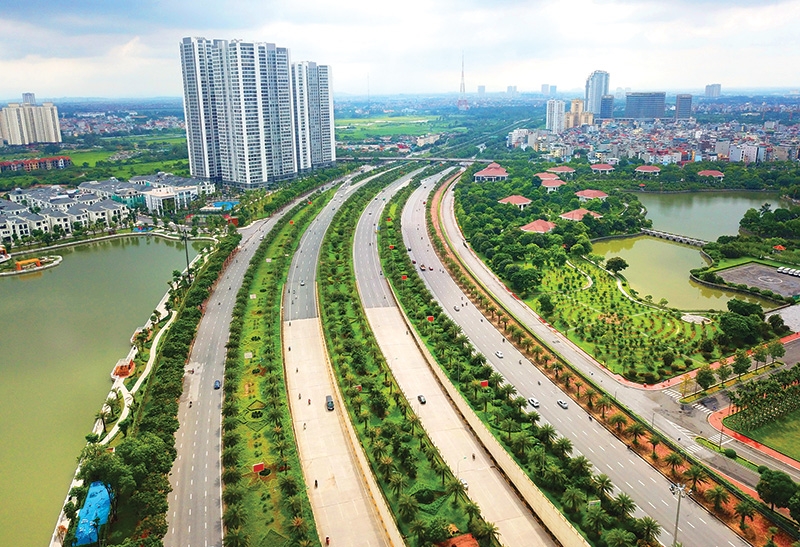Working together to secure a green nation
 |
| Smart and reliable transport across the country is one of the top priorities for Vietnam’s development |
Vietnam’s nationally determined contributions were issued in 2015 as a commitment to reduce greenhouse gas (GHG) emissions, contributing to limiting global warming to less than two degrees Celsius by the end of this century. Vietnam’s NDC emission reduction target is 8 per cent compared to the business-as-usual unconditional contribution, and 25 per cent with international support (meaning conditional contribution). To be able to achieve these targets, in October 2016, Vietnam promulgated the Plan for Implementation of the Paris Agreement which lays out activities to reach the emission reduction target.
 |
| Adam Ward, country representative for Vietnam at the Global Green Growth Institute. |
Cities are major contributors to GHG emissions. The International Energy Agency estimated that urban areas currently account for over 67 per cent of energy-related global GHG, which is expected to rise to 74 per cent by 2030. It is estimated that 89 per cent of the increase in CO2 from energy use will be from developing countries.
Urban design and mobility are crucial to GHG emission reductions. It is not urbanisation alone that increases emissions, but rather how people move about the city, the sprawl of the cities, and how people use energy that make the difference in how cities pollute and contribute to climate change. Rapid urbanisation, coupled with population growth, has led to an increase of municipal solid waste generation in Vietnam by 12 per cent per year, with over 80 per cent of waste sent to uncontrolled dumpsites. Cities are also large consumers of energy: in 2035 the total final energy demand will be nearly 2.5 times higher than in 2015. The energy and waste sectors represent 52 and 7 per cent of Vietnam’s national GHG emissions, respectively.
Latest NDC performance
To lower emissions from cities it is important to decarbonise the power cities use, and Vietnam has made great strides in this over the last two years. Around 4.5GW of solar energy has been connected to the grid, and the new wind feed-in tariff has kick-started the wind market with increased interest from developers. Both these examples show that when the policies are set correctly, the private sector will flood in with the necessary investment.
Solar rooftops are another important technology that has seen increased action of late. Ho Chi Minh City saw over 900 households, offices, and enterprises install rooftop solar power by the end of 2018, increasing total installed capacity by nearly 52 times compared to five years ago. Though small overall, this is a great step in the right direction as solar rooftops are still at the very early stages of development in Vietnam due to a lack of supporting policies, but they have huge potential.
To address the financing gap for these types of projects, the Global Green Growth Institute (GGGI) is currently developing a solar financing facility to be launched later this year to see the rapid scale-up of solar rooftops across Vietnam.
We are starting to see waste-to-energy technologies in Vietnam. This, together with recycling and reducing waste, will be crucial for Vietnam to tackle its growing waste challenge. It starts at the collection of recyclable materials. Currently only around 15 per cent of top-end plastics are collected – compared to around 85 per cent in South Africa – which means there is lots of room for improvement.
However, there are a number of recently launched initiatives that will help, such as the joining together of nine private sector companies including Coca-Cola, Pepsi, and Nestlé to launch the Packaging Recycling Organisation Vietnam, with the aim of improving packaging collection and recycling from participating brand owners and other stakeholders. This scheme will help drive the circular economy and ensure packaging recycling is more accessible and sustainable across Vietnam.
The GGGI is also working to launch a waste-to-energy plant in the northern province of Bac Ninh, partnering with the local government as well as the Finnish government and developer Thang Long to establish a $60 million, 10MW waste-to-energy plant that will process up to 500 tonnes of waste a day using the latest Finnish technology.
Transport is another crucial area for achieving Vietnam’s NDC and for cities to achieve green growth. Hanoi is already planning to build up a smart traffic management system that manages traffic flows based on volume and provides live information on public transport to reduce journey times.
A bus app has been launched for users to find the best route, and buses are equipped with GPS and cameras to provide information back to the centre on traffic and for the timing of buses being displayed at bus stops. This is a great first step, but cities across the country should also prioritise electric mobility to cut pollution and improve air quality. It is great to see that VinFast, together with Siemens, will be producing electric buses in Vietnam, which will support this necessary transport evolution.
We have seen the roll-out of bus-rapid transit in Hanoi and Ho Chi Minh City, an excellent, cost-effective way to move people around a city, but for these to be a success, it is imperative that bus lanes are reserved for buses and policed – ensuring they move more quickly than scooters and cars to encourage their use. The metros, when built, will also support the much-needed increase in public transport usage.
Difficulties ahead
Vietnam is facing several challenges in achieving its NDC targets. Green finance is key, with the Ministry of Planning and Investment estimating that an additional $30 billion is needed by 2030. Accessing this finance will require clear, attractive policies, together with financial products such as green bonds. As mentioned previously, only a small amount of waste is recycled in Vietnam, with household separation (and subsequent collection separation) extremely low. This needs to be an urgent priority. Further, although there are a significant number of policies and regulations on solid waste, Vietnam does not have a legal system of enforcement in cities and provinces. Co-ordination challenges between concerned agencies result in overlapping responsibilities between national, provincial, and city governments.
Households and businesses make for the fastest growing demand of energy in urban areas, accounting for 43 per cent of the total annual electricity consumption and 25.7 million tonnes of CO2 emissions. Commercial services and household appliances are projected to be the fastest growing sector in terms of end-user energy demand.
Many cities in Vietnam have set targets for public transport to increase its modal share to 25-45 per cent in 2020-2030, whereas currently few have higher than 10 per cent, though this is increasing, but more needs to be done to prioritise public transport and to encourage people to switch from private to public transport.
To support the essential renewable energy transition, it is crucial for the main grid to be decarbonised. Vietnam needs to continue the successes we have seen recently, with distribution of more solar across the country (compared to the current concentration in the south and a few select provinces) together with a strengthening of the grid to dispatch power to where it is needed most – in the cities. The cost of renewables continues to fall and by embracing this energy revolution, cities can be powered cleanly and more efficiently while creating green jobs and boosting economic growth.
Cities contribute the majority of total GHG emissions and achieving the NDC will require all cities to embrace green growth. City governments each have a unique set of capacities and political opportunities for reducing GHG emissions.
Reducing them will require individuals and organisations to make new choices about how they invest, what they buy, how they behave, and what they build. It is not just what city governments do, but also how they do it that matters. Many actions to adapt urban areas to climate change also have positive mitigation impacts, and vice-versa, providing a win-win for city climate action.
Recent analysis by the World Bank showed that Vietnam is well on track to reach, and surpass, its 8 per cent voluntary commitment due to the gains made in renewable energy. The same analysis showed that Vietnam could achieve 30 per cent reduction by 2030 too – showing that Vietnam should scale up its NDC ambition.
Given that over 50 per cent of Vietnamese will live in cities by 2030, Vietnam cannot achieve the UN Sustainable Development Goals and the Paris Agreement without tackling the key challenges of energy, waste, transport, and energy efficiency. City leaders in Vietnam have the drive to create sustainable urban centres for future generations – given the right enabling environment, the targets in the NDC can be achieved and even exceeded.
What the stars mean:
★ Poor ★ ★ Promising ★★★ Good ★★★★ Very good ★★★★★ Exceptional
Related Contents
Latest News
More News
- Linking sci-tech and innovation to Vietnam’s net-zero future (December 18, 2025 | 14:31)
- Driving double-digit growth through green and circular transformation in Vietnam (December 17, 2025 | 09:00)
- Standard Chartered and ACCA deepen collaboration to develop Vietnam’s talent for a sustainable future (December 15, 2025 | 18:18)
- Schaeffler reports strong early output from Dong Nai solar project (December 12, 2025 | 15:16)
- Forestry conference highlights biodiversity and sustainability goals (December 09, 2025 | 13:35)
- Home Credit honoured among top 10 sustainable companies in trade and services (December 09, 2025 | 12:18)
- SCG and seven member companies honoured in Top 100 Sustainable Businesses 2025 (December 08, 2025 | 09:00)
- Nestlé Vietnam pioneers sustainable development and promotes business connections (December 06, 2025 | 12:09)
- CSI 2025 highlights rise of Vietnam’s green champions (December 06, 2025 | 09:00)
- Acecook Vietnam named among top 100 sustainable businesses (December 06, 2025 | 08:00)

 Tag:
Tag:






















 Mobile Version
Mobile Version